(Almost) Amazing
Review Summary
The ASRock Phantom Gaming X870 Nova WiFi is a solid mid-range offering, boasting features you’ll find on more expensive motherboards. It looks great, performs solid, and has just about everything you could ask for at this price point. Just look out for the bandwidth sharing complications of the M.2 slots.
Hours Tested: 13

Overall
-
Performance - 9/10
9/10
-
Design - 9/10
9/10
-
Features - 8.5/10
8.5/10
-
Value - 9/10
9/10
Pros
- Eye-catching design
- Solid VRMs (incl. 18x 80A SPS for VCore)
- Excellent VRM cooling
- 5x M.2 slots
- 5G LAN, USB4, WiFi 7
Cons
- Lane-sharing between M.2 and PCIe_2, USB4, and SATA ports
If you’ve followed the ASRock motherboard reviews we’ve covered for the current generation, you probably know that we’ve been very happy with them. Well, we’ve got another one in store today: the ASRock Phantom Gaming X870 Nova WiFi. While the PG X870E Nova WiFi was released last year, ASRock took its time with this one.
Now, if you’re familiar with the difference between X870 and X870E, you’ll know that the X870 chipset has fewer usable PCIe lanes. This will be represented in the lane sharing among the M.2 slots and the USB4 ports, something we’ll get to in the review. There’s a $50 price difference between the X870 and X870E models.
Key Takeaways
- The ASRock Phantom Gaming X870 Nova WiFi is an excellent mid-range motherboard, offering a great design, a wealth of features, and good performance.
- You should buy this motherboard if you want the best I/O, prefer flashy designs, and/or want some overclocking headroom.
- Don’t buy this motherboard if you don’t want to deal with the potential lane-sharing hassle between the M.2 slots and the other I/O.
Let’s start with the specifications:
| Model | ASRock Phantom Gaming X870 Nova WiFi |
|---|---|
| CPU Support | AMD Ryzen 7000, Ryzen 8000, Ryzen 9000 |
| Memory Support | Up to DDR5 8400+ MT/s (OC) |
| PCIe Slots | 1x PCIe 5.0 x16, 1x PCIe 4.0 x16 (supports PCIe x4) |
| M.2 Slots | 2x PCIe 5.0 x4, 2x PCIe 4.0 x4, 1x PCIe 3.0 x2 |
| SATA Ports | 2x 6 GB/s |
| Audio | Realtek ALC4082 Audio Codec |
| Network & Connectivity | Realtek 8126 5G LAN, WiFi 7, BT 5.4 |
| USB Ports | 20 Ports, including 2x 40Gbps Type-C (Rear) |
| Size | 305 mm x 244 mm, mATX |
| MSRP | $300 |
Packaging and Unboxing
The motherboard comes in a cardboard box with a futuristic design. On the front of the box, you get some of the key features and the motherboard model.
As for accessories, this is all that we found inside:
- 2x SATA data cables
- 2x WiFi antennas
- 1x ARGB splitter cable
- 1x thermistor cable
- A quick installation guide
Nothing out of the ordinary here. We saw the addition of a thermistor connector in many other motherboards of this generation.
Design
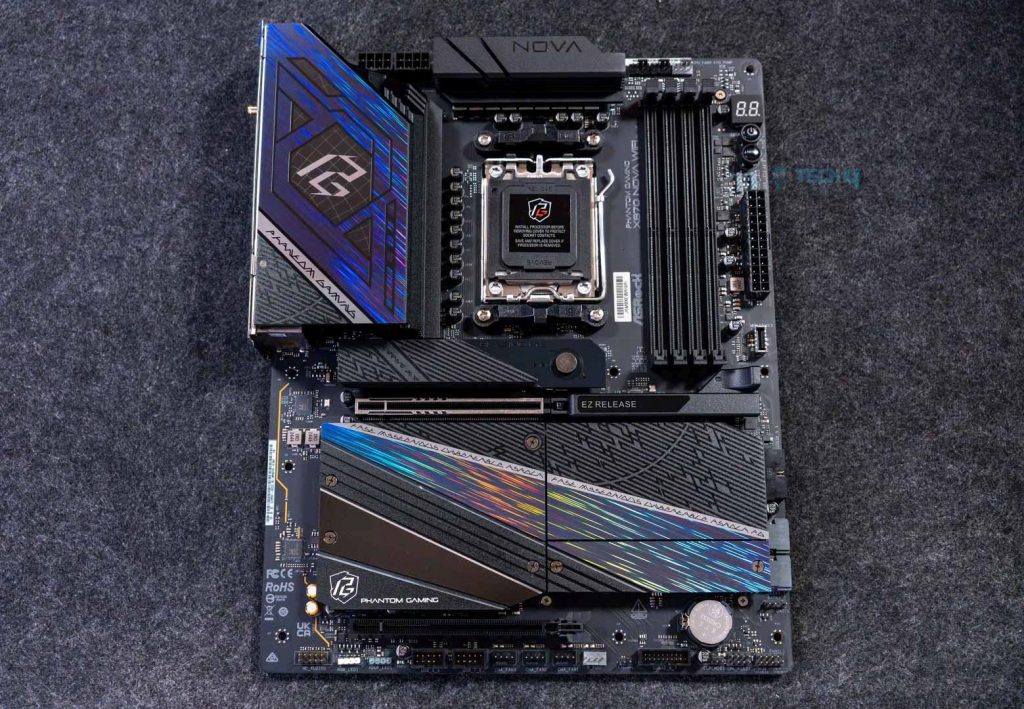
The PG X870 Nova WiFi has a fairly flashy, gaming-inspired design. A large part of the motherboard is covered with heatsinks, on which we see several shapes and designs. The Phantom Gaming branding can be seen on the rear I/O cover and M.2 heatsinks. We also have holographic streaks running through them, giving off a futuristic look. Integrated RGB is found under the large M.2 heatsink, providing a fair bit of illuminance.
The motherboard has an 8-layered PCB with 2oz copper.
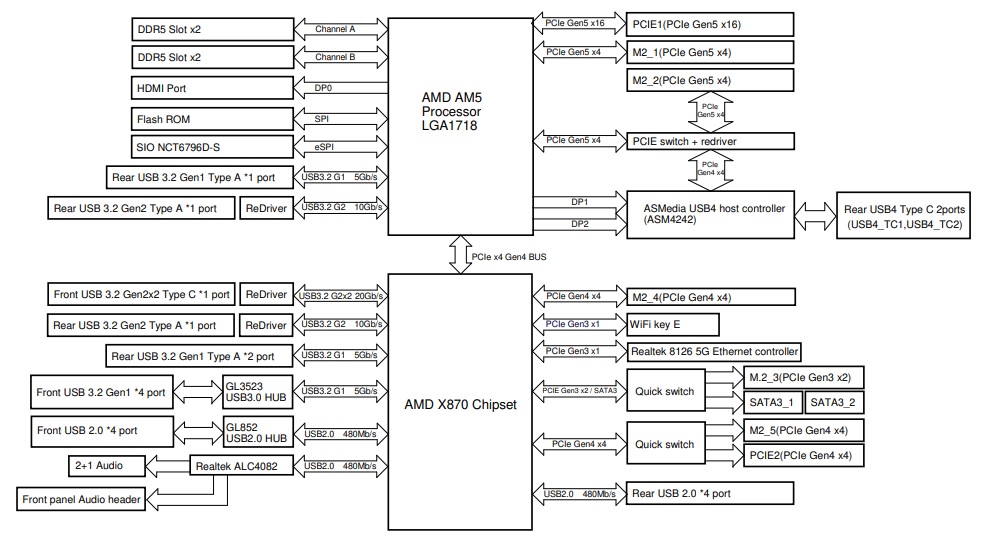
The CPU provides the DDR5 memory, PCIe Gen 5, USB4, and some of the USB connections. Meanwhile, the chipset adds the remaining USB ports, M.2 slots, and PCIe 4.0, as well as audio, WiFi, and LAN.
CPU Socket and Power Delivery
The X870 Nova WiFi uses the AM5 (LGA1718) socket, with support for Ryzen 7000, 8000, and 9000 series CPUs. Power is provided by an 18+2+1 phase VRM system, including 18x 80A SPS for the VCore. The total current for the CPU is 1440A, plenty for any supporting Ryzen CPU, even if you overclock.
A closer look at the VRMs reveals that the VCore is using MPS’ MPS2425 MOSFETs, managed by the MPS2434/MP2857 PWM controller. ASRock is using “upgraded” capacitors with a 20,000-hour lifespan and 1000μF capacitance.
Power to the CPU comes from 2x 8-pin EPS “Hi-density” connectors, capable of providing up to 300W in total.
The heatsinks tasked with cooling the VRMs have a stacked fin design and thermal pads. There’s no heatpipe connecting the heatsinks.
DIMM Slots
The ASRock Phantom Gaming X870 Nova WiFi can run up to 256 GB of DDR5 RAM across the four DIMM slots. For speed, the maximum support is 8400+ MT/s. (OC)
As always, it’s important to note that the recommended memory speed for Ryzen 9000 CPUs is 6400 MT/s. Beyond this, the memory controller can’t sync with the RAM anymore and switches to a 1:2 mode. If you really want to push beyond 6400 MT/s, you’ll need speeds upwards of 8000 MT/s to see any notable results.
– Dr. Usman Saleem
PCIe Slots
The motherboard has two PCIe slots, with the main slot offering full PCIe 5.0 x16 bandwidth. While the secondary slot is also 16 lanes, it only supports x4 mode. The slot downgrades to x2 mode if the M2_5 slot is occupied. There is also a vertical M.2 slot, which runs the WiFi antenna provided in the package.
The PCIe 5.0 slot is surface-mounted by SMT and steel-reinforced. This should allow it to withstand the weight of bulky cards without damage, but we still recommend using a support bracket with high-end cards.
Removing your graphics card is easy thanks to the EZ Release mechanism on the Gen 5 slot. Simply pull the latch away from the card’s direction and remove the card.
Storage
Storage options on the board include a whopping five M.2 slots (two PCIe 5, two PCIe 4, one PCIe 3×2) and two SATA 6 GB/s ports. However, due to the limited number of usable PCIe lanes, there is bandwidth between the M.2 slots, PCIe slots, SATA ports, and the USB4 ports. Specifically, occupying M2_2 mode disables both USB4 ports (you can set it to x2 (64 Gbps), and that will mean USB4 will run at half the bandwidth, too). Occupying M2_3 disables both SATA ports, and using M2_5 means the second PCIe slot downgrades to x2 mode.
It’s great that ASRock decided to provide this many M.2 options, but the bandwidth sharing complications don’t help casual users. Make sure you evaluate your needs, considering how many M.2 slots you need and whether or not you’re willing to sacrifice USB4, SATA ports, and PCIe 2 for the extra M.2 slots. All M.2 slots support type 2280 SSDs, and the third M.2 slot (M2_3) can also run SATA SSDs.
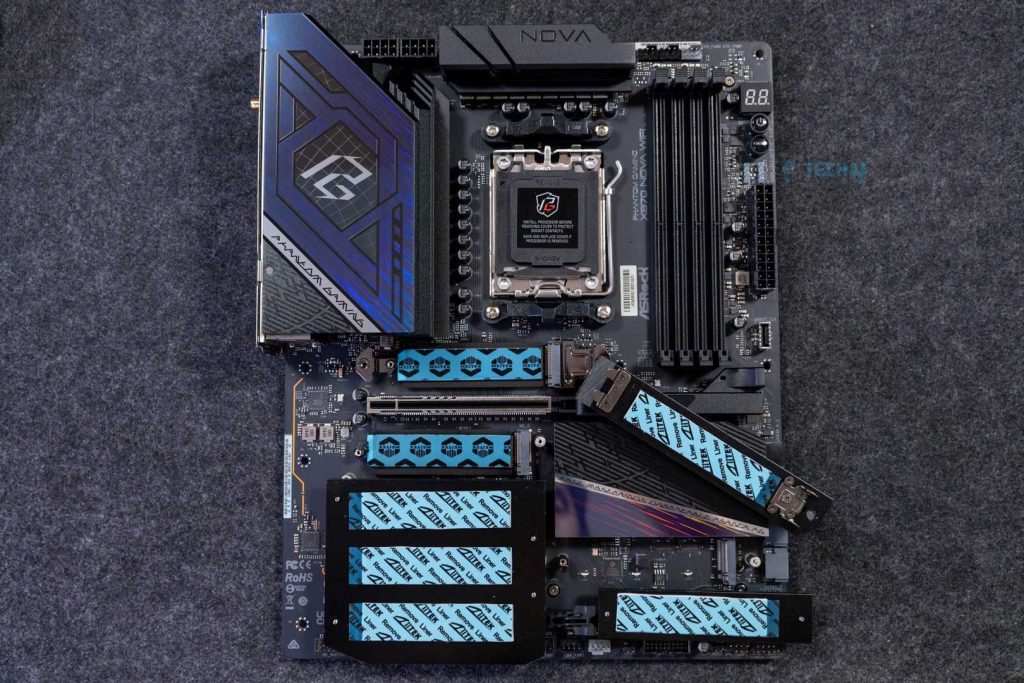
Cooling the Gen 5 slot is its own large heatsink. The three M.2 slots directly below it share another heatsink, and M2_5 has a separate heatsink. Above M2_5 lies the chipset heatsink. All the heatsinks come off easily owing to toolless removal mechanisms.
Removing the heatsinks, we are greeted with double-sided thermal pads (thermal pads on the base of the slot as well as on the heatsink itself) for the Gen 5 slots. The remaining slots are single-sided. (thermal pads only on the heatsink)
The M2_1 slot uses a toolless mechanism for drive installation and removal. For the remaining slots, we have the latch mechanism, which is also straightforward to work with.
USB connectivity
There are 20 USB ports on the ASRock Phantom Gaming X870 Nova WiFi:
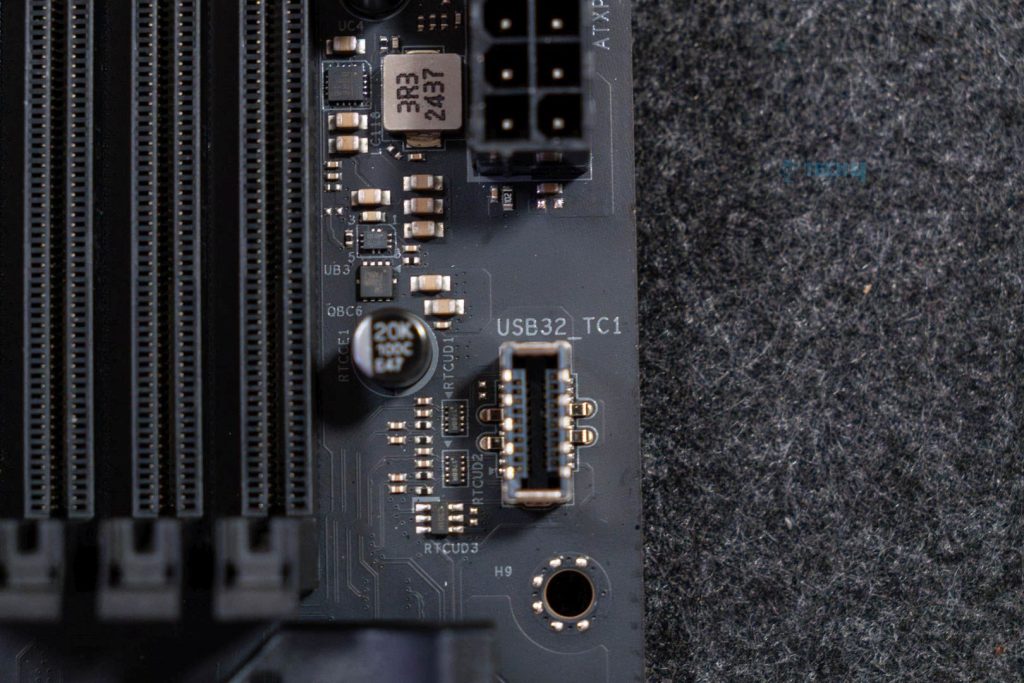
- 2x USB4 Type-C (Rear)
- 1x USB 3.2 Gen2x2 Type-C (20Gbps)(Front)
- 2x USB 3.2 Gen2 Type-A (Rear)
- 7x USB 3.2 Gen1 Type-A (3x Rear, 4x Front)
- 8x USB 2.0 (4 Rear, 4 Front)
All the ports have ESD protection. The 20Gbps port supports 36W charging, while the USB4 ports support 15W charging through PD 3.0. USB4 supports up to 8K 30Hz output through HDCP 2.3.
ASRock gives special mention to “Lightning Gaming Ports,” which use separate interfaces so that there’s no interference between the mouse and keyboard connections. We also have the “Ultra USB Power” ports that provide stable 5V power by converting the PSU’s 12V power, instead of using the 5V line. This could be helpful for those using external DACs and USB audio devices.
Network and Connectivity
The motherboard sports 5G LAN, WiFi 7, and Bluetooth 5.4. WiFi 7 and Bluetooth 5.4 is enabled through the provided antenna and are only supported on Windows 11 24H2 and above.
Audio Solution
The ASRock Phantom Gaming X870 Nova WiFi uses Realtek’s ALC4082 chip, which supports 7.1 surround sound. With the left and right audio tracks present on different PCB layers, interference is minimized.
ASRock provides Nahimic audio drivers in collaboration with Steelseries, which provide features like echo cancellation and stationary noise suppression.
Internal Connectors and Components
Here’s what we get on the motherboard in terms of connectors:
- 1x Thermistor Cable Header
- 1x Power LED and Speaker Header
- 1x RGB LED Header
- 1x Addressable LED Headers
- 2x CPU Fan Connector (4-pin)
- 3x Chassis Fan Connectors (4-pin)
- 1x AIO Pump Fan Connector (4-pin)
- 1x Water Pump Fan Connector (4-pin)
- 1x 24-pin ATX Power Connector
- 2x 8 pin 12V Power Connectors
- 1x Front Panel Audio Connector
- 2x USB 2.0 Headers (Support 4x USB 2.0 ports)
- 2x USB 3.2 Gen1 Headers (Support 4x USB 3.2 Gen1 ports)
- 1x Front Panel Type C USB 3.2 Gen2x2 Header (20 Gb/s)
- 1x Dr. Debug with LED
- 1x Power Button with LED
- 1x Reset Button with LED
The RGB leader header provides up to 12V/3A (36W), while the LED headers provide 5V/3A (15W). The CPU fan has a 1A/12W output, while the remaining fan connectors and pump connectors output 3A/12W.
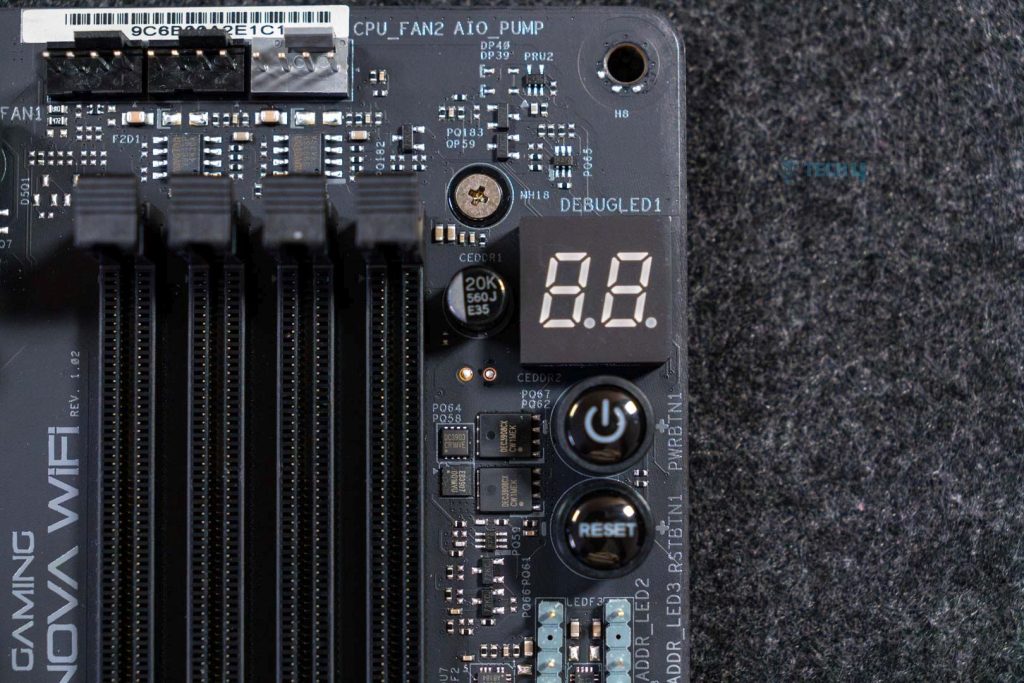
We have a debug code LED panel on the top-right side for troubleshooting booting problems. This is not accompanied by debug LEDs, though. Below that are Power and Reset buttons, which will function once you connect to the bottom right-hand corner of the board.
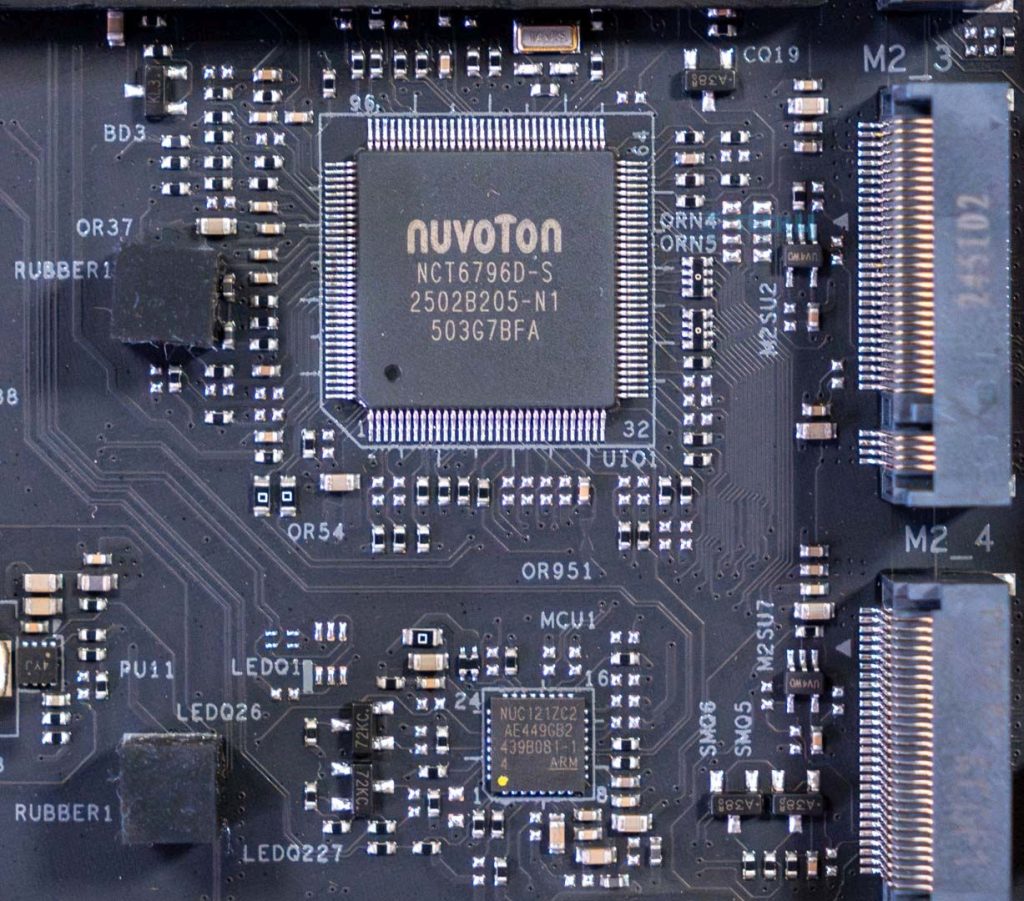
The board uses Nuvoton’s NCT6796D-S controller for fan control and temperature monitoring.
Rear I/O Panel
Here’s what we have on the back:
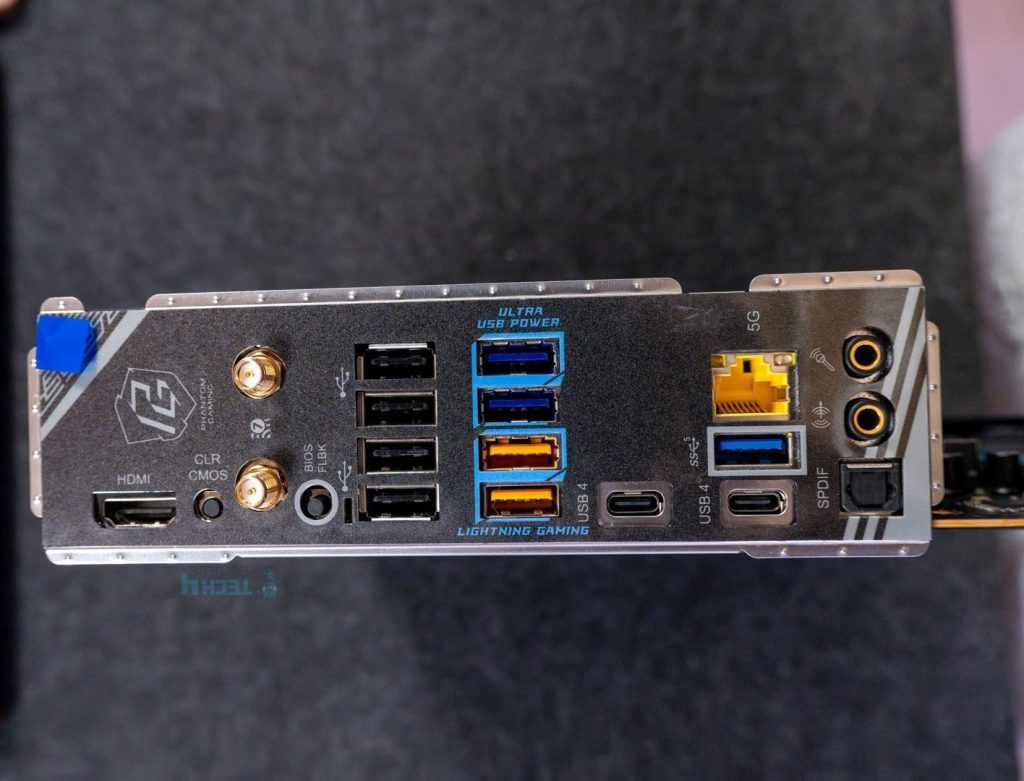
- 2x Antenna Ports
- 1x HDMI Port
- 1x Optical SPDIF Out Port
- 2x USB4 Type-C Ports (40 Gbps)
- 2x USB 3.2 Gen2 Type-A Ports (10 Gbps)
- 3x USB 3.2 Gen1 Type-A Ports (5 Gbps)
- 4x USB 2.0 Ports
- 1x RJ-45 LAN Port
- 1x Clear CMOS Button
- 1x BIOS Flashback Button
- 1x Line Out Jack
- 1x Microphone Input Jack
The I/O shield comes pre-installed. A standard set of rear I/O connections is on display. The yellow colored USB ports (5 Gbps) are the Lightning Gaming ports, while the dark blue ones (10 Gbps) are the Ultra USB Power ports.
Heatsinks Removed
Above is a look at the board with all the heatsinks (except the chipset heatsink) removed. Under the VRM heatsink, we spot another heatsink that is dedicated to cooling the USB4 controller.
Backside
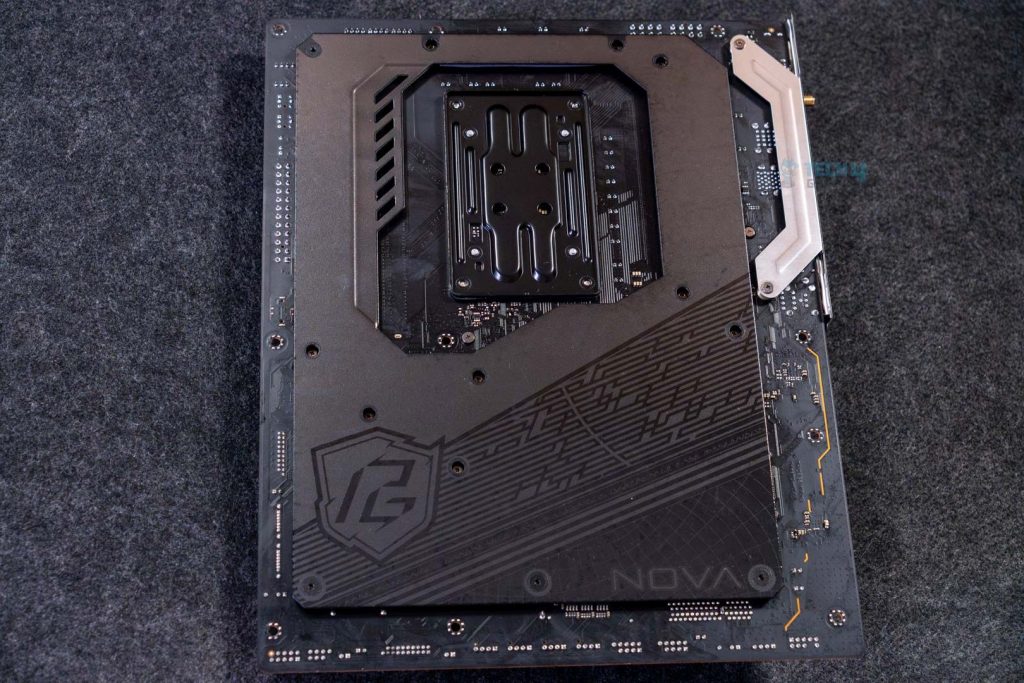
The backplate is a nice addition in this price segment. It’s a plus one for the build quality and sturdiness.
Test Setup
Here’s what our test bench looks like:
- AMD Ryzen 9 9950X 16C/32T
- ARCTIC Liquid Freezer II 420 Liquid CPU Cooler
- G. Skill Trident Z5 Royal NEO DDR5-8000 CL36 EXPO Kit (2×16 = 32GB)
- XPG Lancer RGB 32GB 7200MHz DDR5 RAM
- Nvidia GeForce Gigabyte RTX 4090 Gaming OC
- Western Digital SN850 Black 500GB NVMe SSD [For OS]
- Sabrent Rocket 4 Plus 2TB Gen4x4 NVMe SSD [For Software]
- Sabrent Rocket 4 Plus 4TB Gen4x4 NVMe SSD [For Games]
- Sabrent Rocket NANO V2 4TB Portable SSD
- Corsair HX1200i Platinum PSU
- Windows 11 Pro Build 23H2
- AGESA 1.2.0.2 firmware
Synthetic Benchmarks
As always, we start with the synthetic tests.
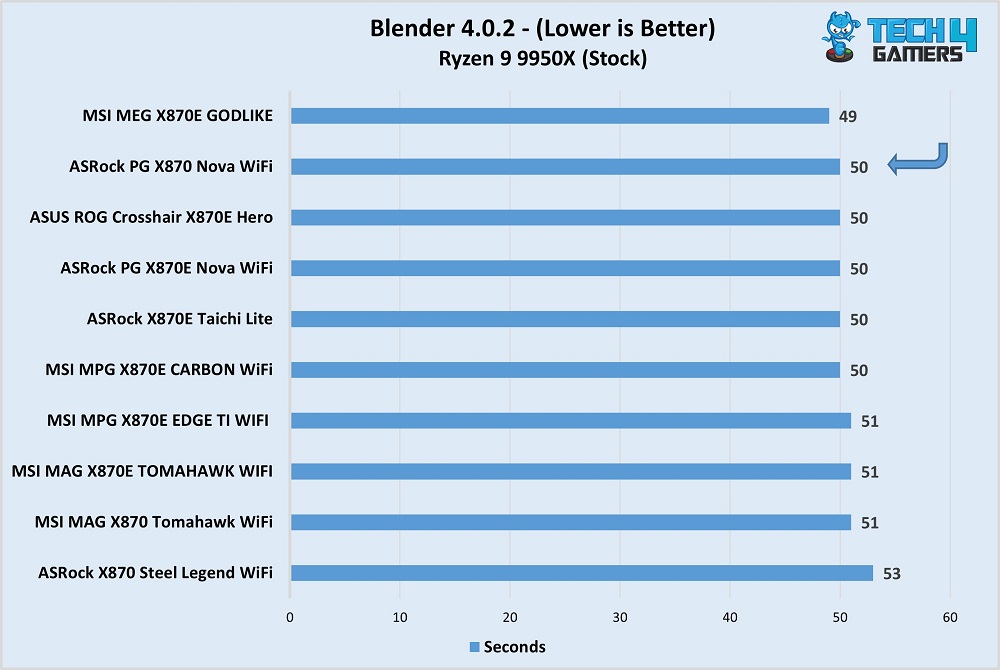
The ASRock PG X870 Nova WiFi managed a 50-second render time.
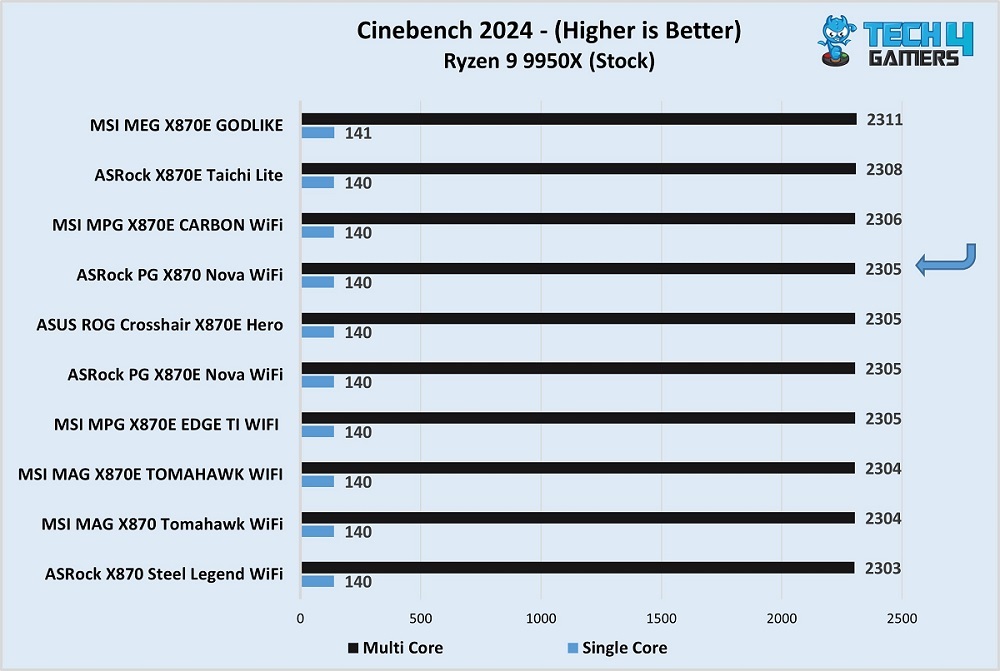
We managed a score of 2305 and 140 in the multi-core and single-core tests, respectively.
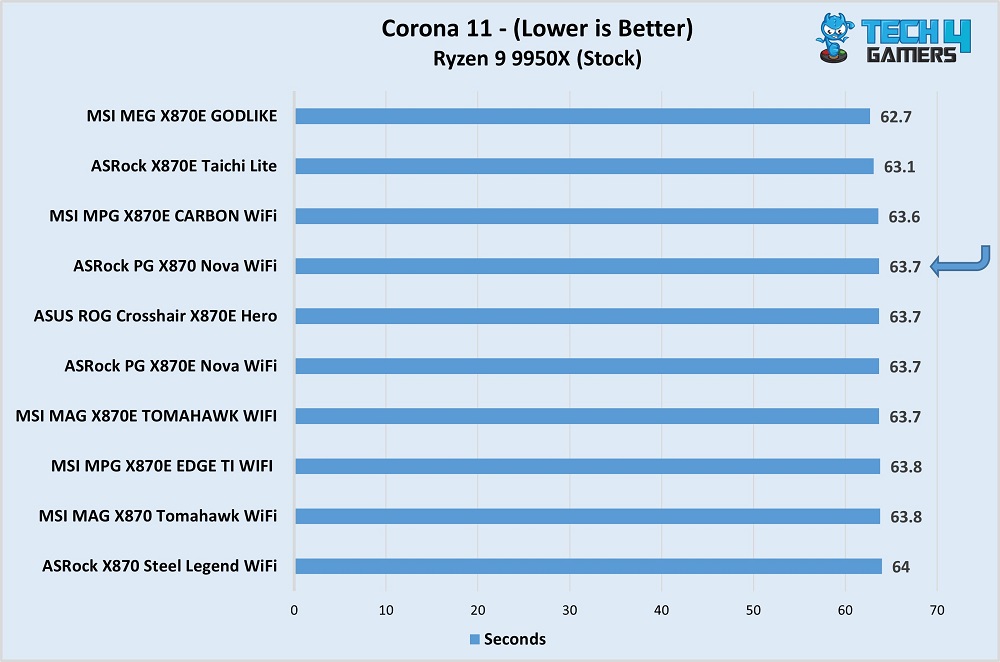
The Corona 11 render time for the board was 63.7 seconds.
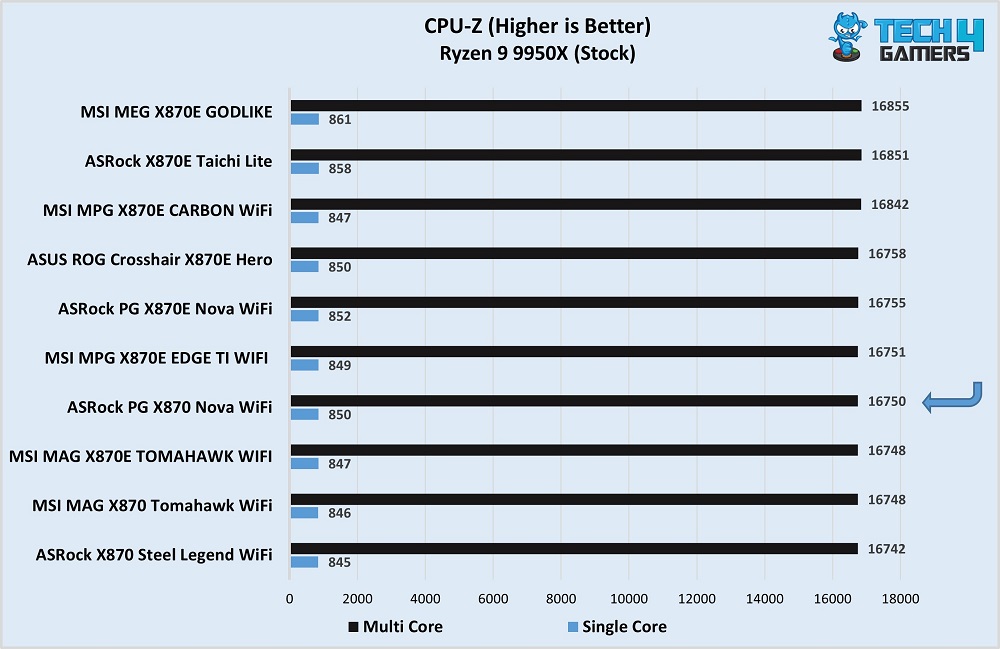
CPU-Z’s multi-core and single-core tests put the board just above MSI’s MAG X870E Tomahawk WiFi.
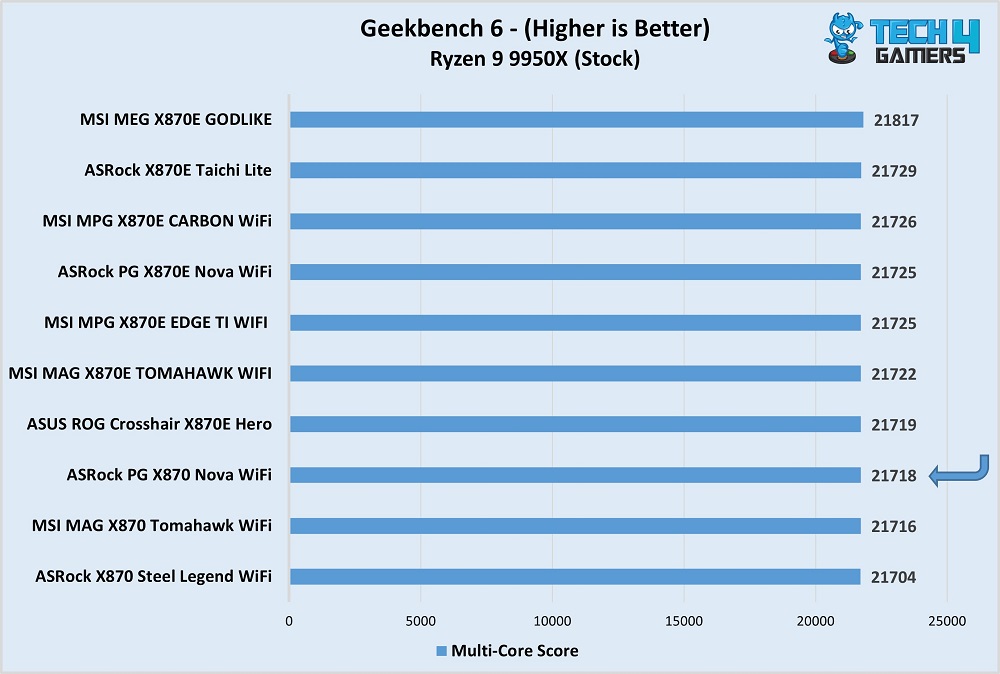
The Geekbench 6 multi-core test saw the PG X870 Nova WiFi score 21718 points.
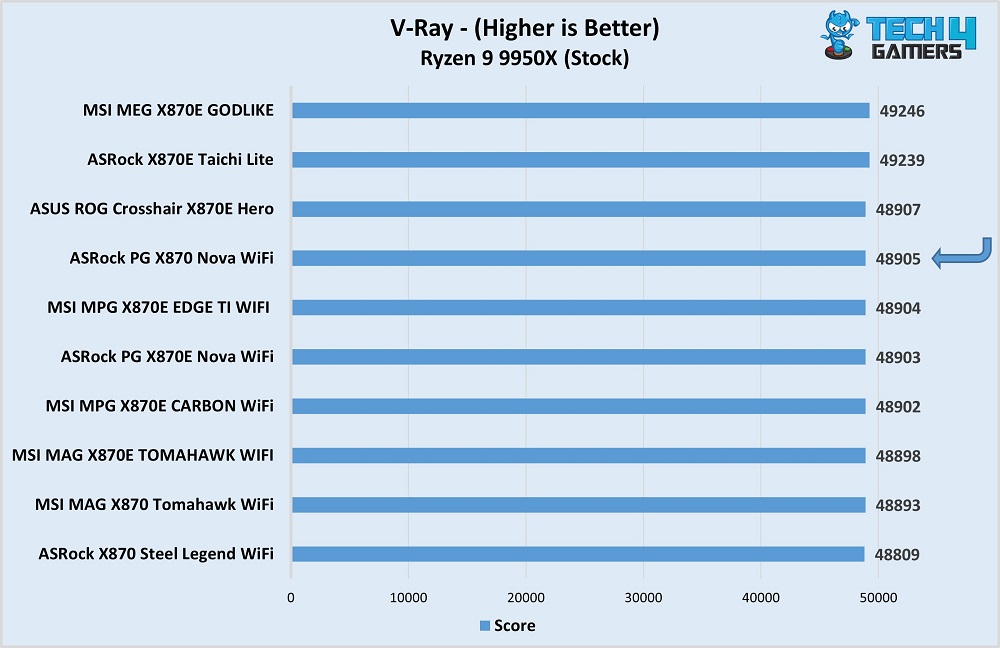
Finally, the V-Ray render test ended with a score of 48905 for our ASRock board.
Gaming Benchmarks
We’re testing two AAA titles next.
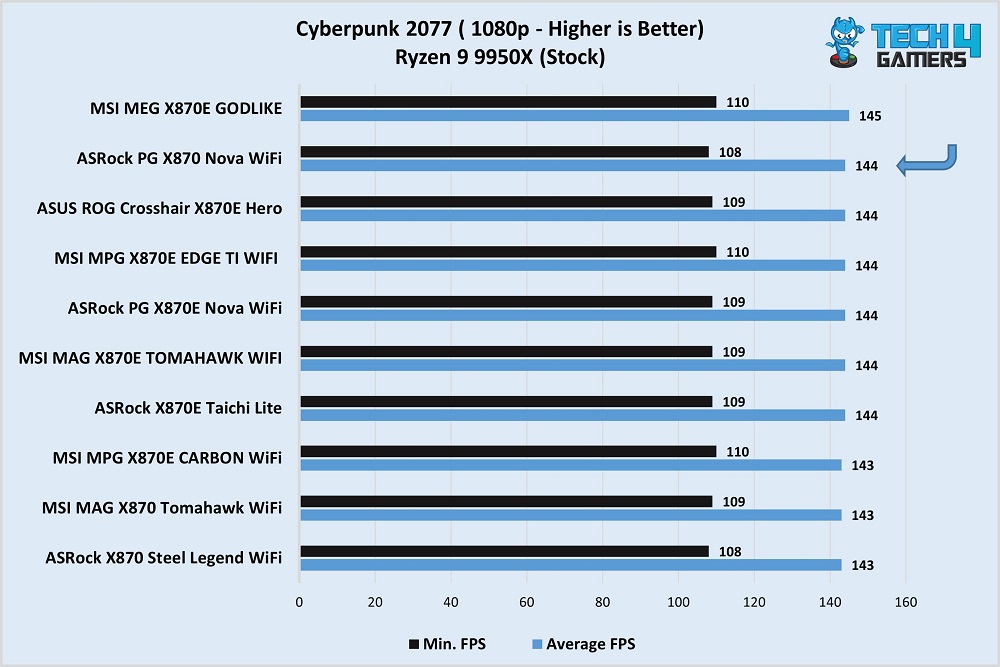
The board showed par numbers in Cyberpunk 2077 at 1080P.
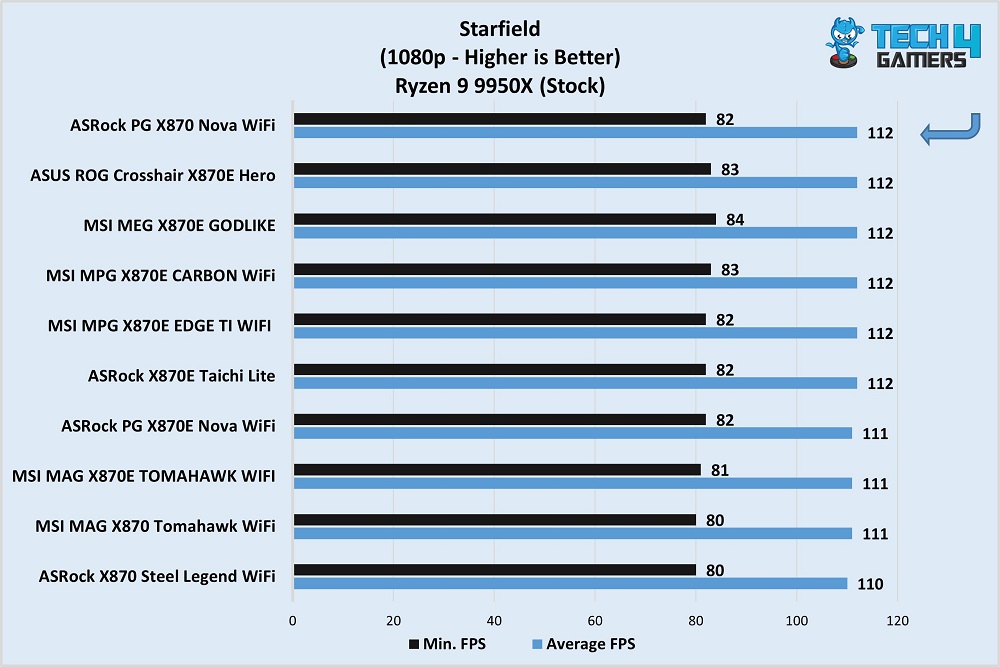
In Starfield, we saw an average FPS of 112 with a minimum of 82.
Power Consumption and VRM Temperatures
Let’s look at the board + CPU power consumption numbers. Note that we’re using the Cinbench 2024 multi-core test for the “Load” testing.

Only the ASRock X870 Steel Legend WiFi consumed less power than the PG X870 Nova WiFi under load. The gaming and idle power consumption were 114W and 108W, respectively.
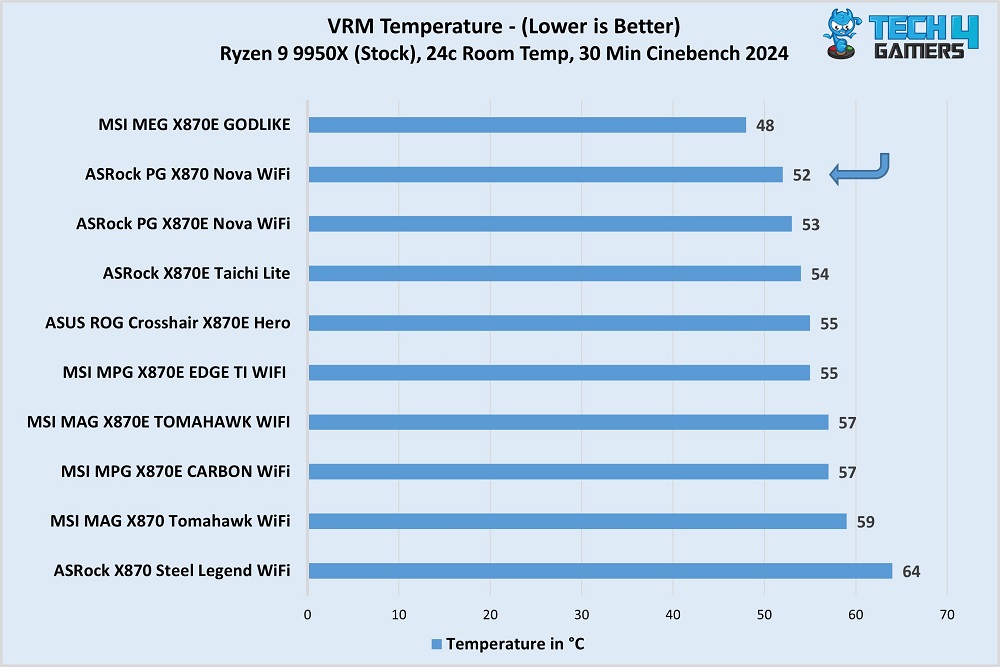
The board’s VRM setup does an excellent job, just like we saw with the X870E counterpart. It maxed out at 52°C, a degree cooler than the X870E model.
Boot Times
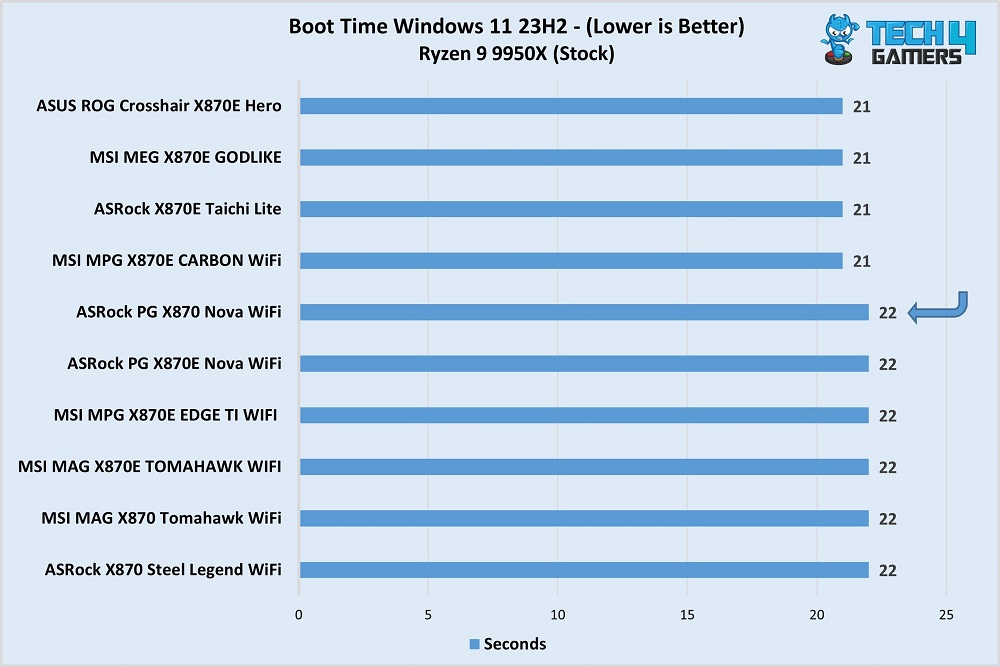
Finally, the boot time in Windows 11 was 22 seconds with the WD SN850 SSD.
Should You Buy It?
Buy It If:
✅You want more for less: The board combines the features of costlier competitor boards for a lower price. This includes features like 5G LAN, 5x M.2 slots, and a debug code LED panel.
✅A flashy design is important: With its gaming-inspired design and integrated RGB, the board has a distinct, flashy aesthetic.
✅You want to overclock: Its VRM setup with 18x 80A SPS for the VCore and excellent VRM cooling means at least a fair bit of overclocking is possible with any Ryzen CPU.
Don’t Buy It If:
❌You don’t want to deal with M.2 bandwidth sharing complications: Depending on which and how many M.2 slots you occupy, you may have to share bandwidth with the SATA or USB ports, or the PCIe_2 slot.
Final Thoughts
The ASRock Phantom Gaming X870 Nova WiFi is another excellent value offering by the Taiwanese manufacturer. It starts with a nice gaming-inspired design with integrated RGB. The VRM setup is quite good for the price, and the heatsink keeps things cool (well, warm) under load. Overclocking is possible, even with the 170W Ryzen counterparts.
Other than these, the board has some other great features: we get 5x PCIe slots (including 2x Gen 5), 5G LAN, 20 USB ports (including dual USB4), and DDR5 support up to 8400 MT/s. The board uses Realtek’s ALC4082 audio chip. WiFi 7 and Bluetooth 5.4 are also part of the connectivity setup. The main M.2 slot uses a toolless mechanism for both the SSD and the heatsink. All the M.2 slots are adequately cooled with thermal pads and heatsinks.
Some other features include the debug code LED panel, 36W charging through the 20Gbps port, and the thermistor header (thermistor cable included). Our only complaint, really, is the lane sharing between the M.2 slots and the other components of the board. The bandwidth is limited, we get it, but it’s not great for users who don’t understand how lane sharing works (though we tried to break it down in simple terms). If you do understand how it works and can work out your requirements, great!
The board is priced around the $300 mark, which is quite good for what’s on offer.
Thank you! Please share your positive feedback. 🔋
How could we improve this post? Please Help us. 😔
[Reviews Specialist]
Usman Saleem brings 8+ years of comprehensive PC hardware expertise to the table. His journey in the tech world has involved in-depth tech analysis and insightful PC hardware reviews, perfecting over 6+ years of dedicated work. Usman’s commitment to staying authentic and relevant in the field is underscored by many professional certifications, including a recent one in Google IT Support Specialization.
8+ years of specialized PC hardware coverage
6+ years of in-depth PC hardware analysis and reviews
Lead PC hardware expert across multiple tech journalism platforms
Certified in Google IT Support Specialization
Get In Touch: usman@tech4gamers.com


 Threads
Threads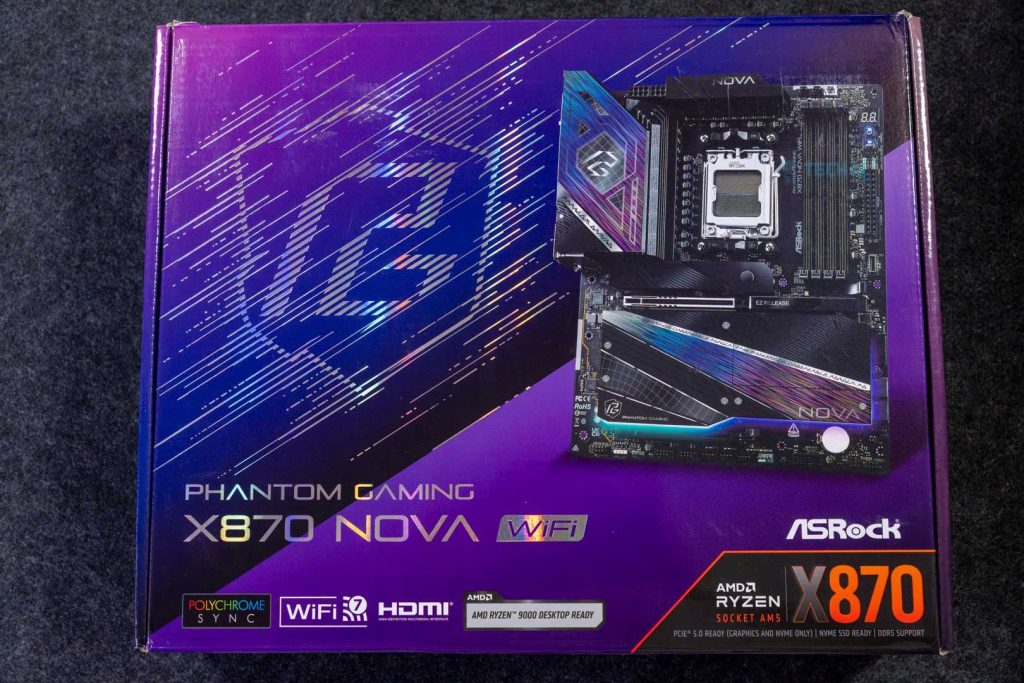
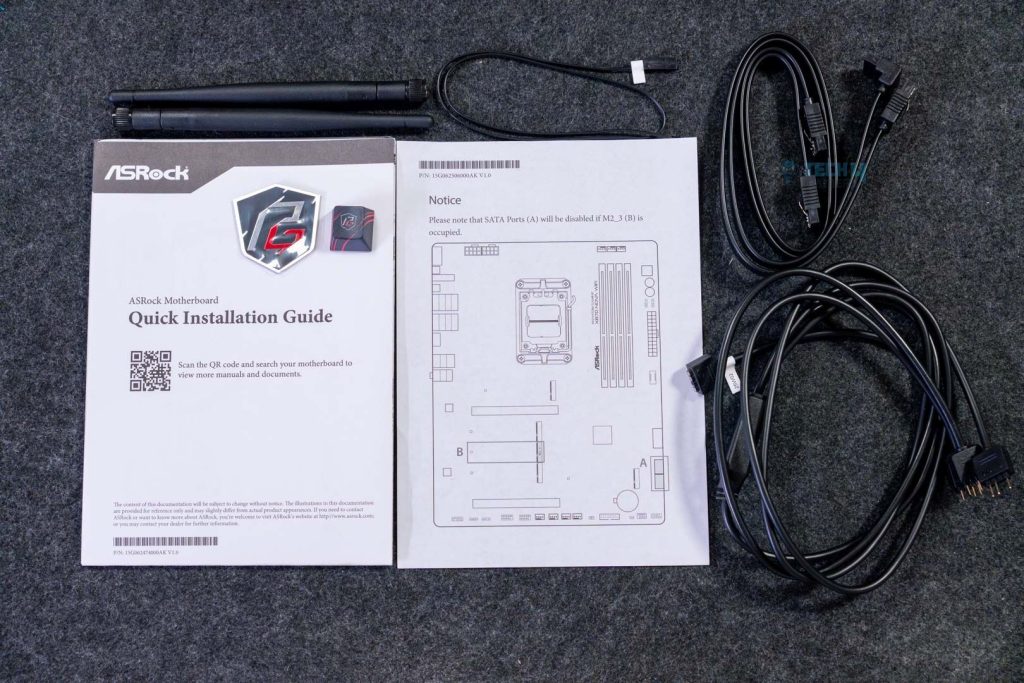
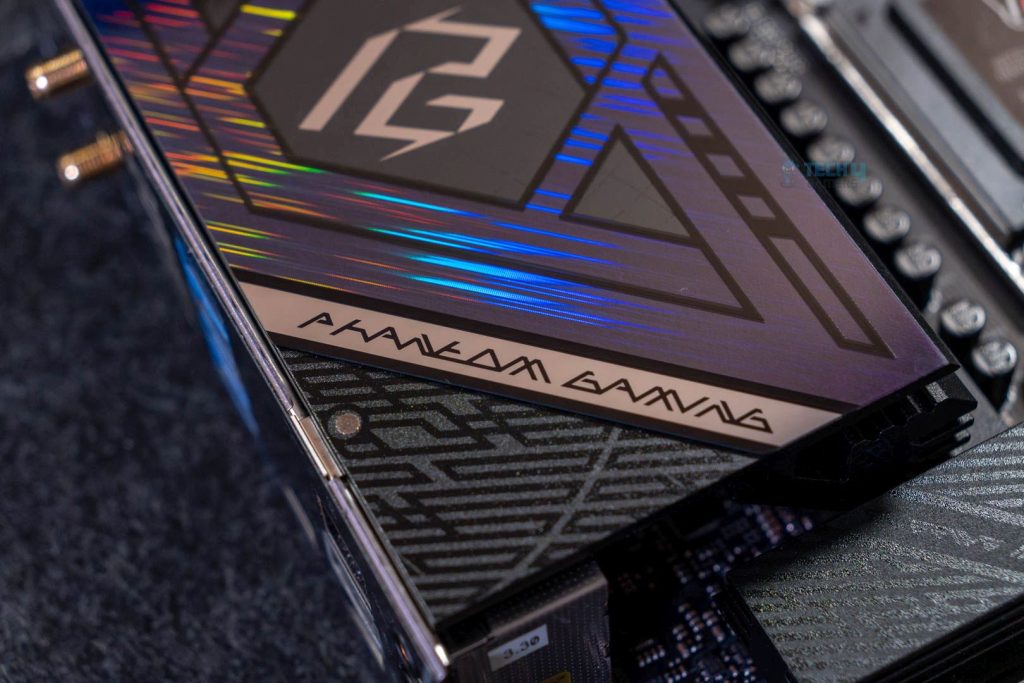
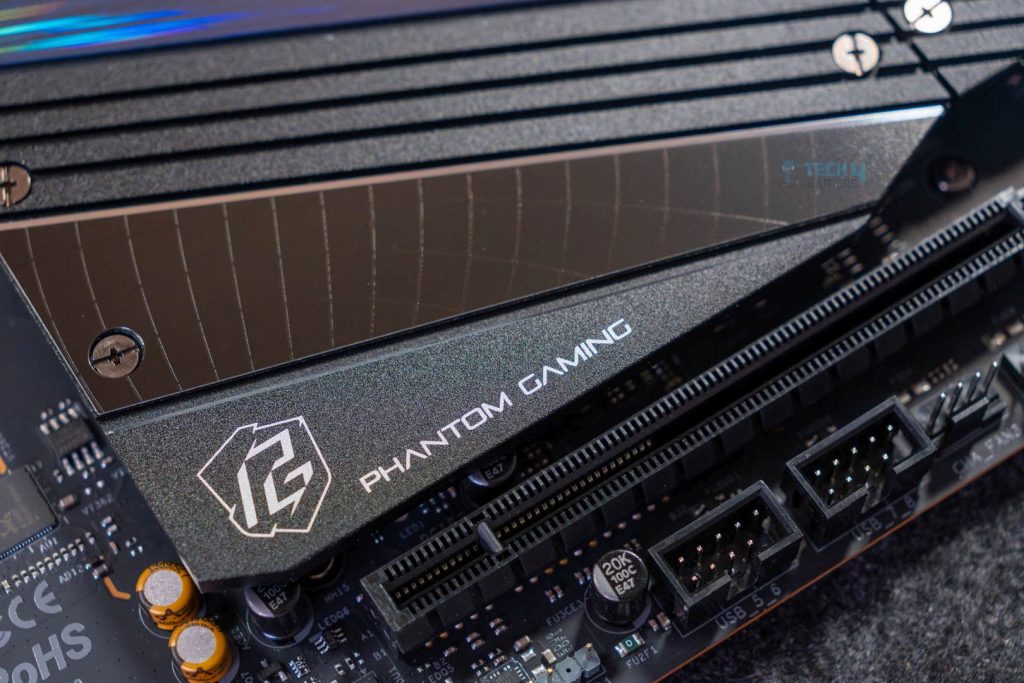
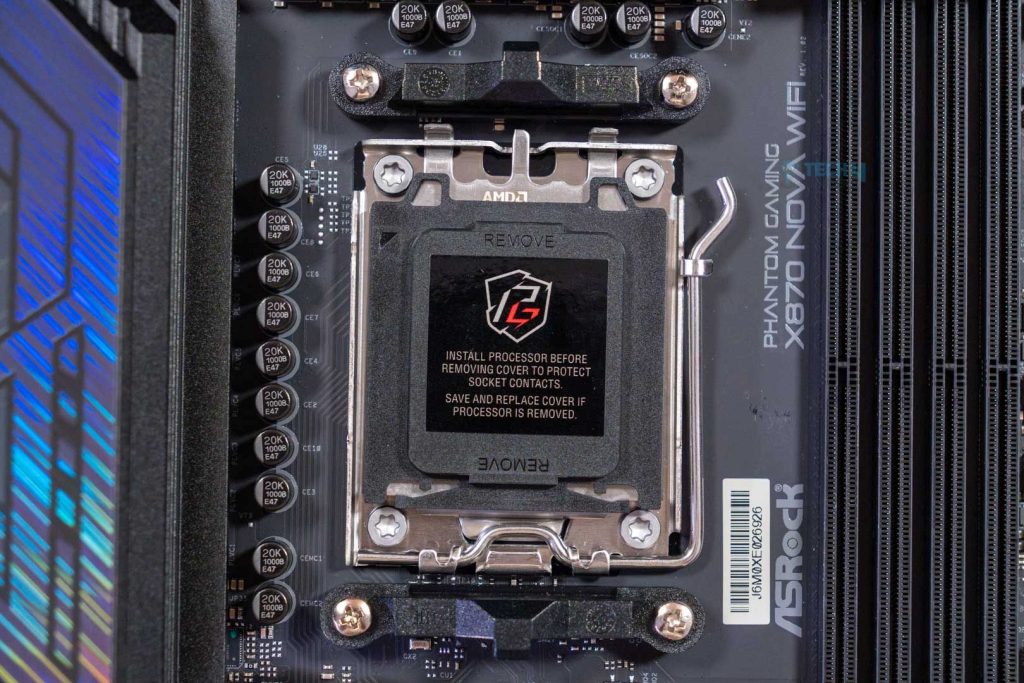
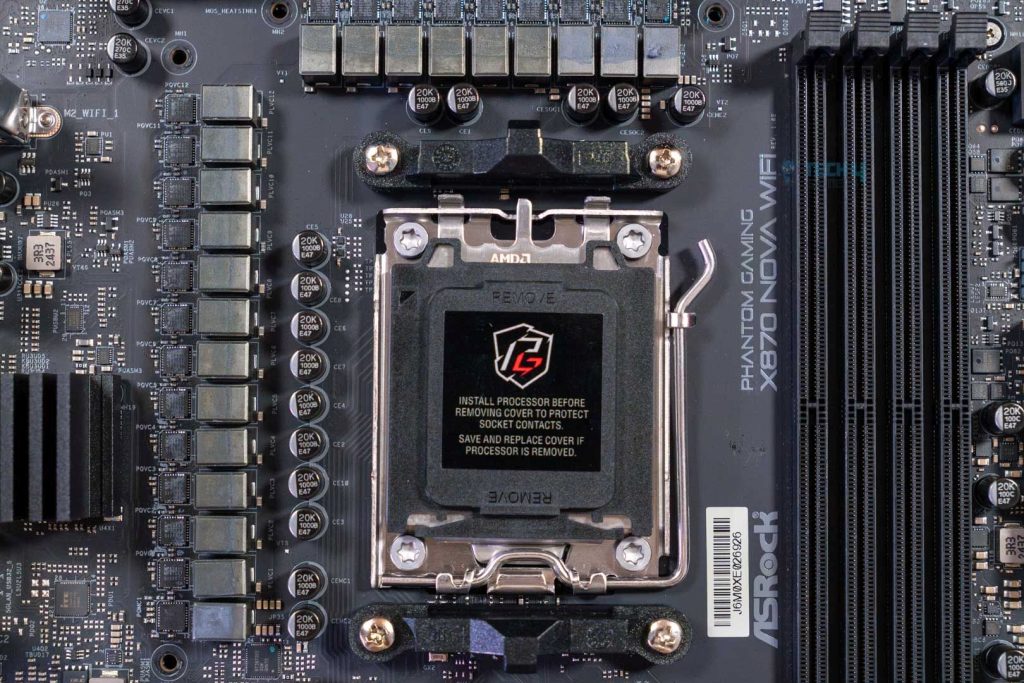
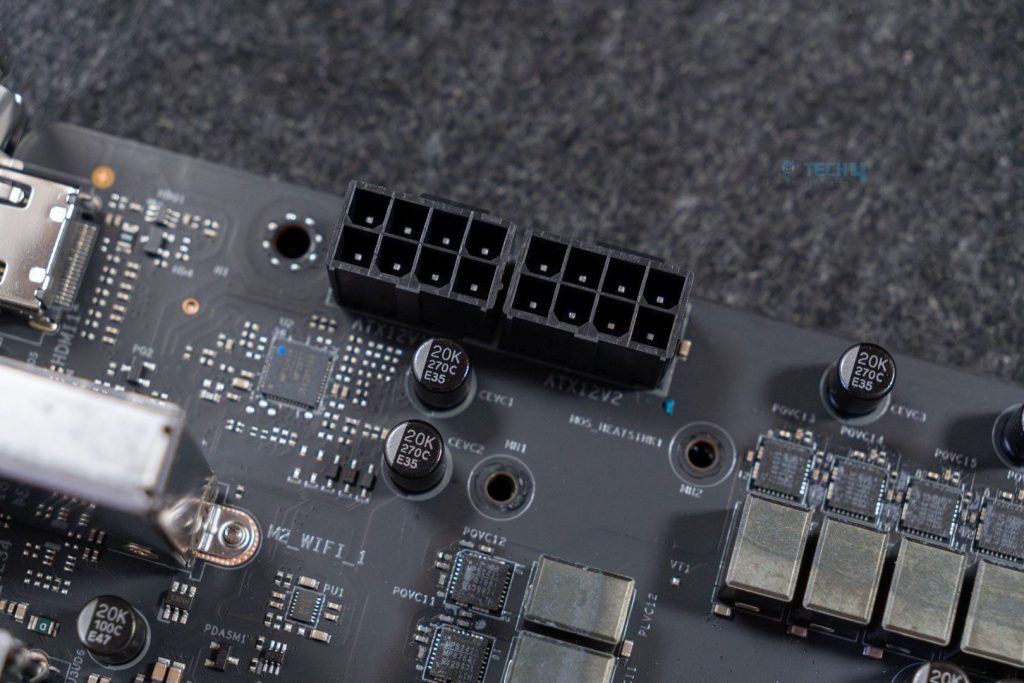
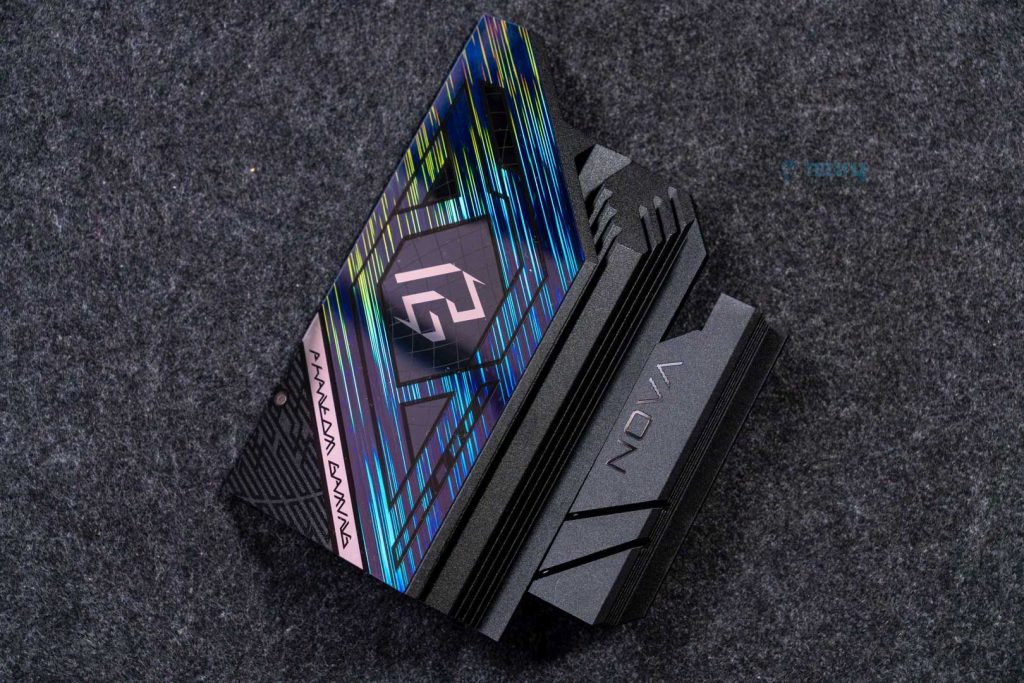

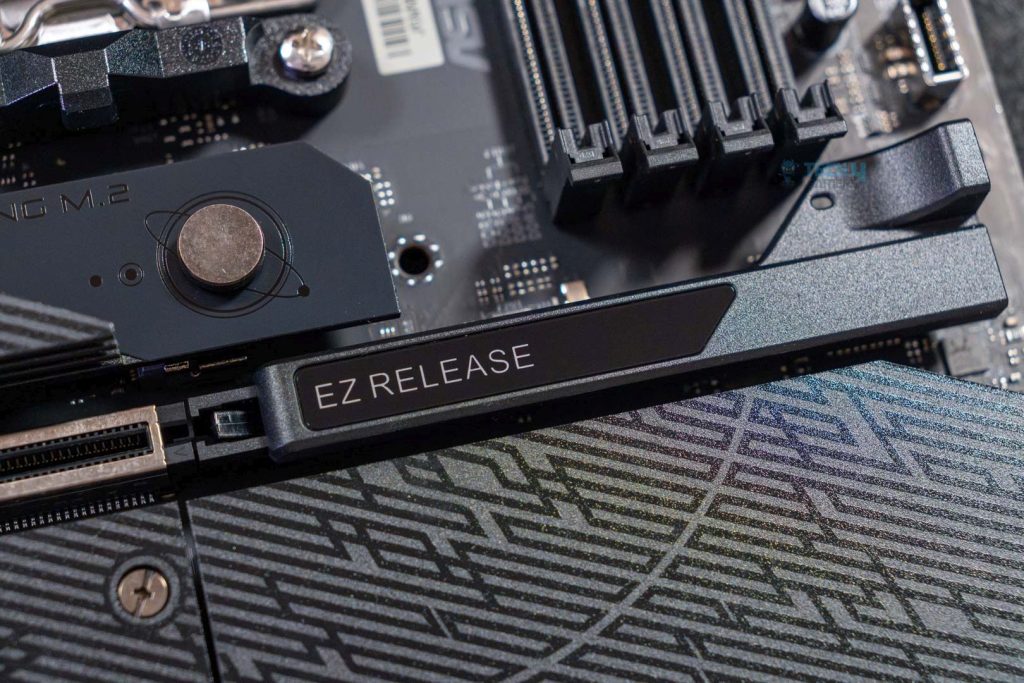
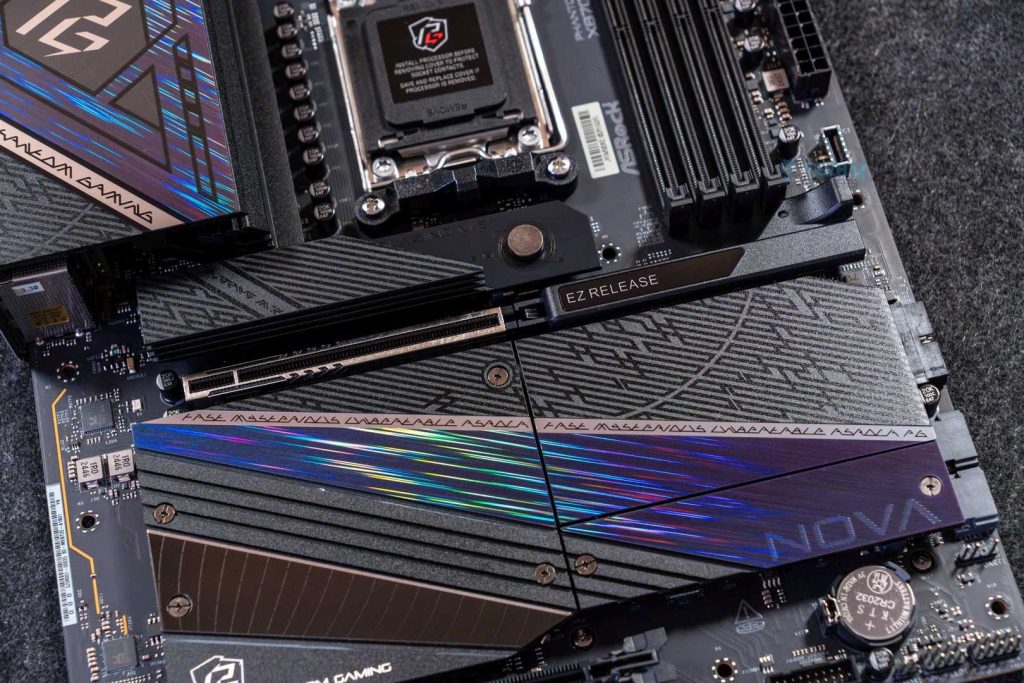

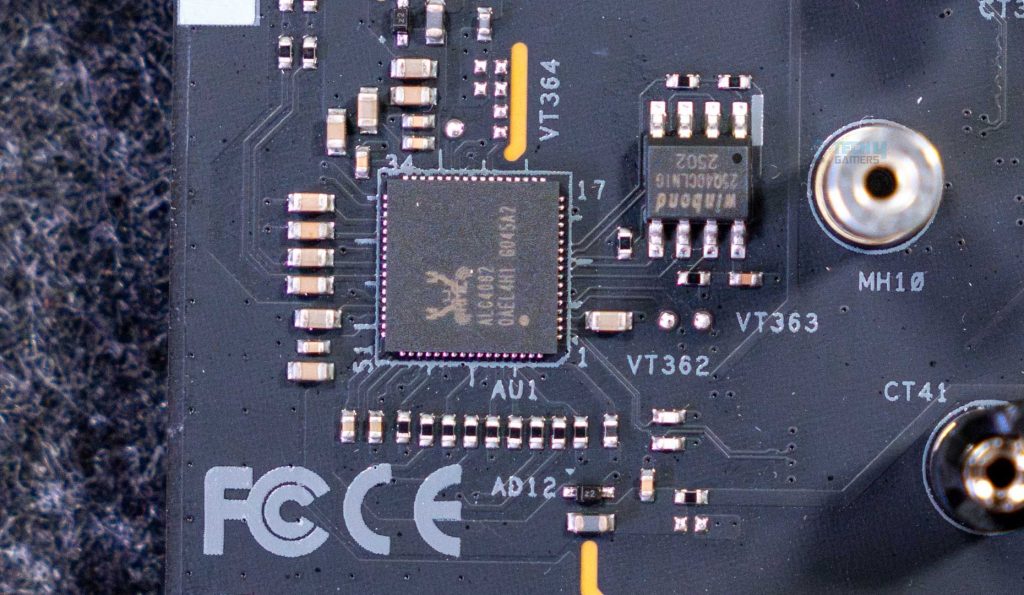
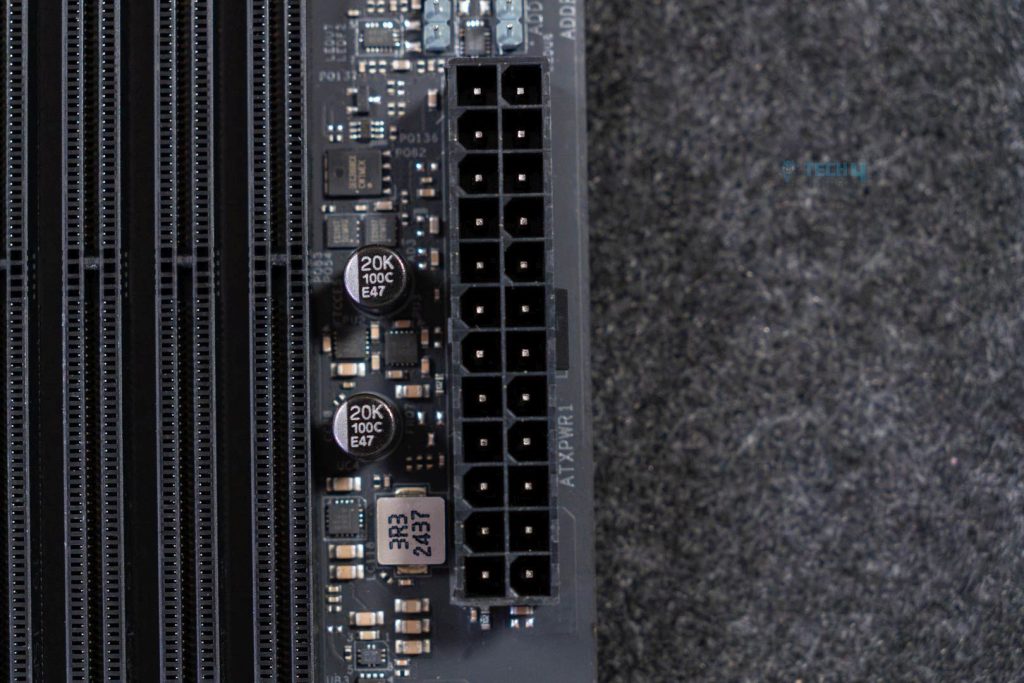

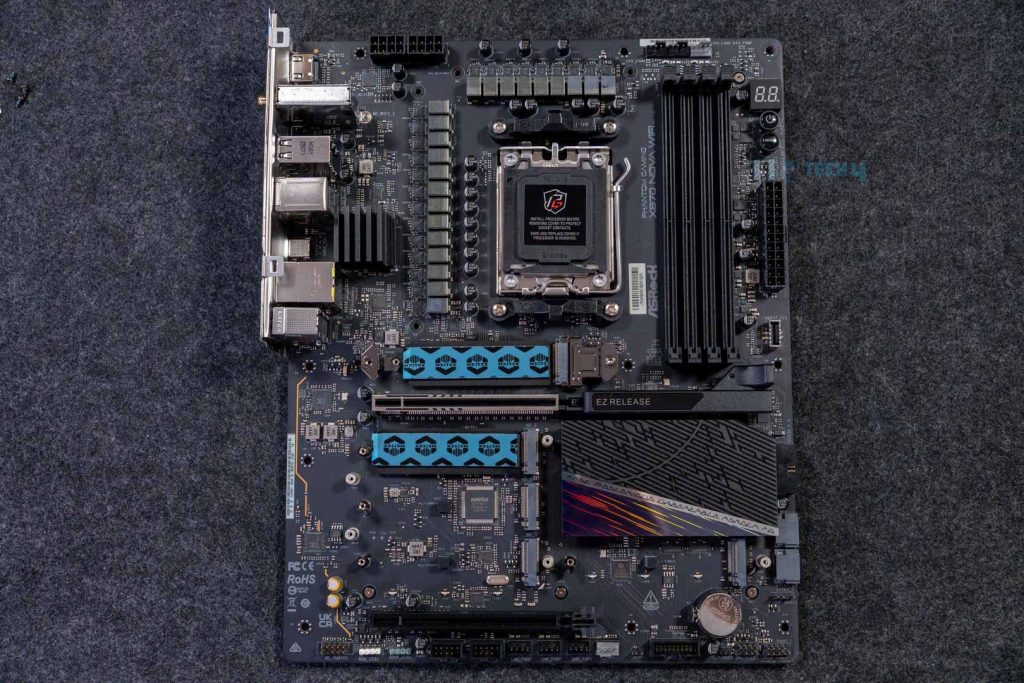
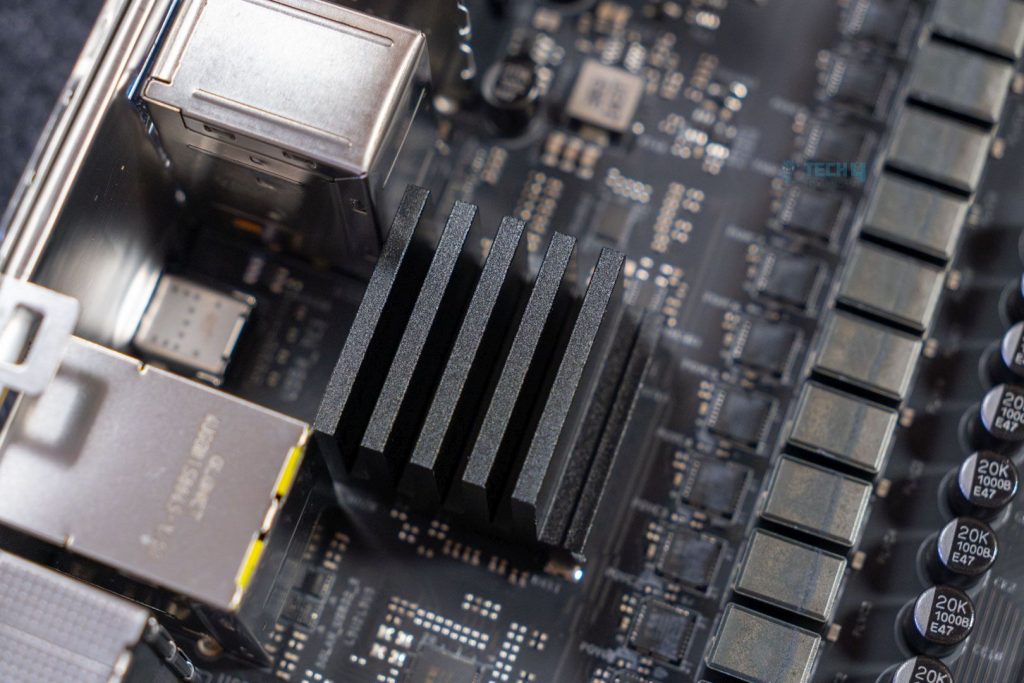
![BEST B450 Motherboard [Top 5] Best B450 Motherboards](https://tech4gamers.com/wp-content/uploads/2022/09/Best-B450-Motherboards-218x150.jpg)


![6 BEST Motherboards For i9-13900KS [Recommended By Experts] Best Motherboards for Intel Core i9-13900KS](https://tech4gamers.com/wp-content/uploads/2023/01/Best-Motherboards-for-Intel-Core-i9-13900KS-218x150.jpg)
